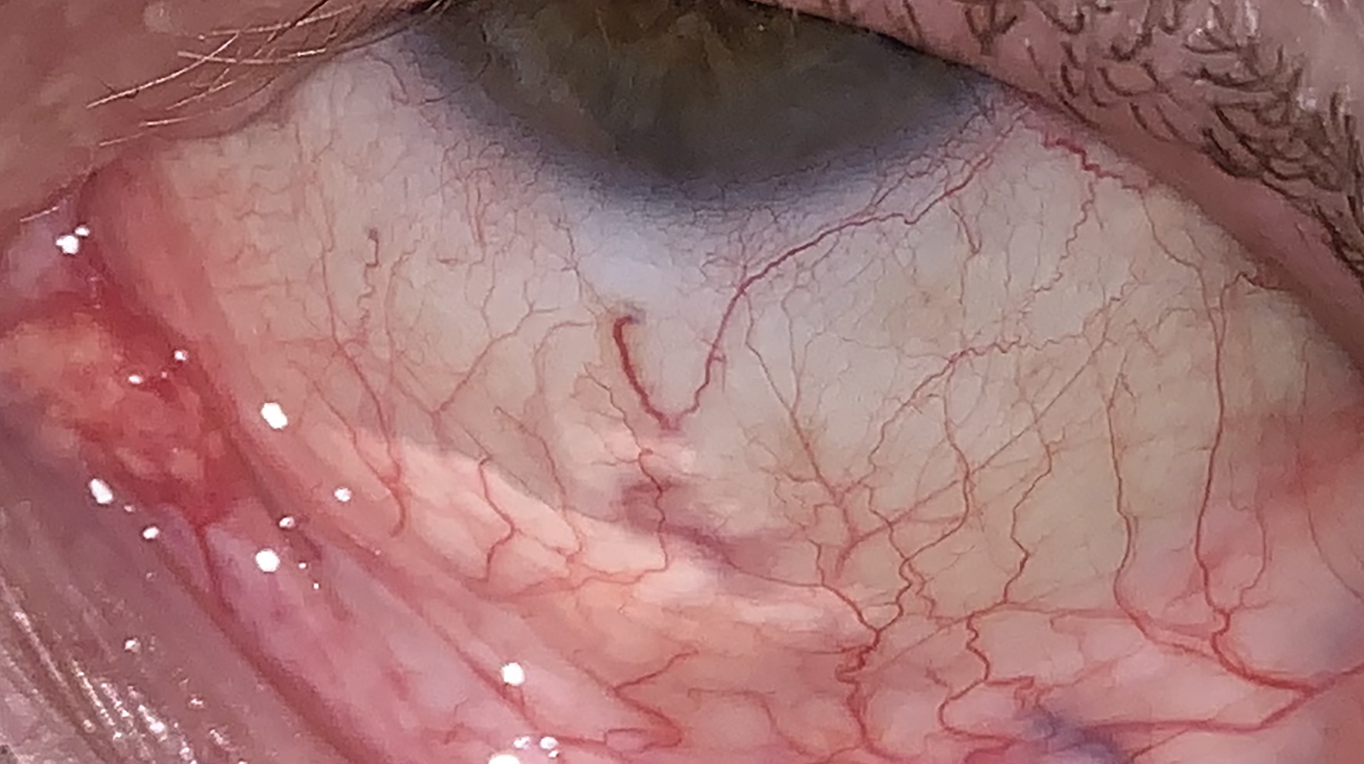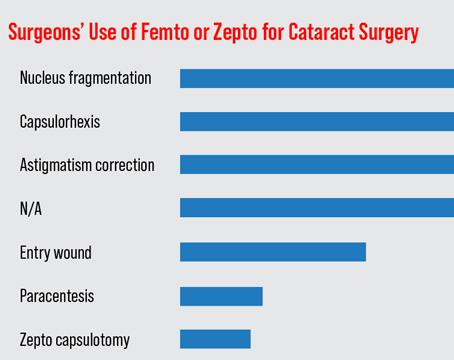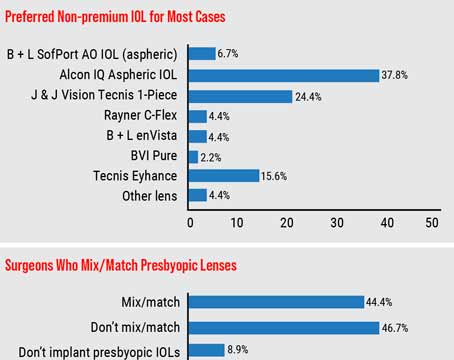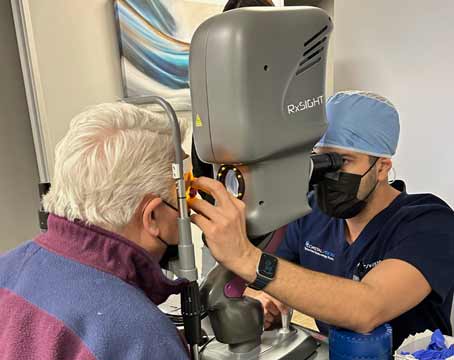Medication non-compliance is one of the biggest obstacles to a successful cataract surgery outcome. Additionally, the required drops are pricey for patients. For these reasons, some surgeons are turning to dropless and less-drops protocols after cataract surgery. Here, physicians who have adopted these strategies detail how they make them work in their practices.
The Rationale
According to Neal Shorstein, MD, who is in practice in Oakland,
California, patient compliance is a significant problem. Even patients who remember to instill the drops at the correct times can have poor technique, which can affect surgical outcomes.
A Canadian study found that postoperative cataract patients inexperienced with eye-drop use showed a poor instillation technique by failing to wash their hands, contaminating bottle tips, missing the eye, and using an incorrect amount of drops.1 Additionally, a large discrepancy was noted between the patients’ perceptions and the observed technique of drop administration.
The study included 54 eye-drop-naïve postoperative cataract patients. Subjectively, 31 percent of patients reported difficulty instilling the drops, 69 percent reported always washing their hands before using the drops, 42 percent believed that they never missed their eye when instilling drops, and 58.3 percent believed they never touched their eye with the bottle tip. Objectively, 50 patients (92.6 percent) showed an improper administration technique, including missing the eye (31.5 percent), instilling an incorrect amount of drops (64 percent), contaminating the bottle tip (57.4 percent) or failing to wash hands before drop instillation (78 percent).
Dropless Techniques
Dropless techniques involve administering medication via injection at the time of surgery and don’t require patients to administer drops at home. Dr. Shorstein and his colleagues at Kaiser Permanente use a subconjunctival injection of triamcinolone, 4 mg of the 10 mg/mL product. “We just published a study showing that subconjunctival triamcinolone is better at preventing macular edema and iritis than a combination therapy of topical prednisolone with an NSAID. So, the pros are obvious,” he says.
This retrospective, comparative effectiveness cohort study included 69,832 eligible patient eyes.2 All eyes received topical prednisolone acetate with or without NSAID and subconjunctival injection of triamcinolone acetonide 10 mg/mL or 40 mg/mL in a low dose (1 to 3 mg) or high dose (3.1 to 5 mg).
Postoperative macular edema occurred in 1.3 percent of eyes in the topical group and in 0.8 percent of eyes in the injection group. Iritis occurred in 0.8 percent of eyes in the topical group and in 0.5 percent of eyes in the injection group, and a glaucoma-related event (e.g., increased intraocular pressure) occurred in 3.4 percent of eyes in the topical group and in 2.8 percent of the eyes in the injection group.
In multivariable analysis, compared with the prednisolone acetate reference group, the prednisolone acetate plus NSAID group had a lower odds ratio of macular edema. All injection groups had even lower odds, with the high-dose (4 mg) triamcinolone acetonide 10 mg/mL group reaching statistical significance.
A trend of lower odds of a postoperative iritis diagnosis was noted in the high-strength (40 mg/mL) groups. For postoperative glaucoma-related events, compared with prednisolone acetate, the triamcinolone acetonide 10 mg/mL low-dose group (2 mg) showed lower odds, the triamcinolone acetonide 10 mg/mL high-dose group showed similar odds, and the triamcinolone acetonide 40 mg/mL low-dose and high-dose groups showed higher odds of an event occurring. In his experience, with 4 mg triamcinolone of the 10 mg/mL product, an additional NSAID isn’t necessary.
“For patients who have advanced glaucoma and are at risk for a corticosteroid IOP response, the downside is that you’re placing a long-acting depot of a corticosteroid under the conjunctiva, which could increase the risk of a postop IOP spike,” Dr. Shorstein says. “In the entire study, there was actually less risk of an IOP response with the triamcinolone injection using the dose and concentration that I just mentioned than with topical prednisolone and NSAID. With that said, there was increased risk of a glaucoma-related event for patients with glaucoma and ocular hypertension so one should be careful in these patients and in those who have a history of high myopia and are relatively young.”
Another technique in the dropless category is an intravitreal injection of triamcinolone and moxifloxacin. “My worry with this technique is injecting into a compartment, namely the vitreous, that we generally try to avoid during cataract surgery. Additionally, few studies have clearly shown what the pharmacokinetics are of an antibiotic and a corticosteroid injection in the vitreous cavity for routine cataract surgery. In contrast, there have been at least 10 peer-reviewed studies that have looked at the subconjunctival location of injection of triamcinolone following cataract surgery going back to 1966. That’s how we got started on this technique,” Dr. Shorstein adds.
He reports that patients are extremely happy about not having to instill drops. “Many of our elderly, cataract population are fearful about the postop care, primarily of putting drops in. When they find out that they’re using a drop-free technique, they’re extremely happy, and they feel reassured that they’re getting the medicine in. It’s injected by the surgeon, and it’s not reliant on the patient at all. They’re very happy about that,” Dr. Shorstein says.
 |
|
Dextenza is placed much like a dissolving punctal plug in the lower lid canaliculus, where it provides about four weeks of a tapering dose of dexamethasone to the eye after surgery. Photo: John Hovanesian, MD. |
John Hovanesian, MD, who is in practice in Laguna Hills, California, also prefers dropless cataract surgery. His regimen consists of Dextenza (dexamethasone ophthalmic insert 0.4 mg, Ocular Therapeutix) and intracameral moxifloxacin at the end of the surgery, which is combined by a compounding pharmacy. “We also have the patient take topical bromfenac once a day for about a month after surgery. That’s our postop regimen for routine cataract surgery. For patients who are diabetic, have epiretinal membranes, or are otherwise at higher risk for postoperative macular edema, we’ll sometimes give bromfenac for up to eight weeks. We sometimes will also give triamcinolone injections subconjunctivally for higher risk diabetics,” he says.
Dr. Hovanesian recently conducted a study to evaluate the clinical efficacy and patient preference for a dropless treatment regimen compared to conventional topical therapy in cataract patients.3
In this prospective, contralateral eye study, patients with bilateral cataract were randomized to receive either intracanalicular dexamethasone insert, intracameral phenylephrine 1%/ketorolac 0.3%, and intracameral moxifloxacin (50 µg) (study group) or topical moxifloxacin 0.5%, ketorolac 0.5%, and prednisolone acetate 1.0% four times daily (control group). The second eye underwent cataract surgery two weeks later and received the opposite treatment. All patients were evaluated at days one, sseven, 14, 28, and three months.
The proportion of patients with no pain was similar in both groups at all postoperative visits. No statistically significant difference in summed ocular inflammation score was observed between the two groups at any visit. The vast majority of patients (94.7 percent) preferred the study eye’s dropless regimen over the control eye’s conventional topical regimen.
The researchers concluded that a dropless treatment regimen is as effective as topical administration. A higher proportion of patients who underwent bilateral cataract surgery preferred the dropless treatment regimen over the patient-administered drop regimen.
According to Dr. Hovanesian, another advantage is cost. “The cost for patients taking a three-drop cocktail was $100 more than the eye that received the single medication, bromfenac. We didn’t measure compliance, but it’s likely that compliance was also superior in the group taking just one drop.”
Dextenza is covered by Medicare, so it’s free to the patient and the surgeon, he says.
However, there are a few downsides. “With glaucoma patients, you must be careful because you’re putting the steroid in at the time of surgery. You must be confident that that patient isn’t likely to have a pressure spike. Fortunately, that’s a rare event, and it’s not difficult to remove Dextenza from the lacrimal canaliculus in the event of a steroid response,” Dr. Hovanesian explains.
He adds that it is a very patient-friendly way to approach surgery. “And, perhaps more importantly, the surgeon is taking control,” he says. “When we give drops, we have no control over whether patients actually pick them up at the pharmacy, and a lot of patients don’t if they’re expensive. And will they take them? Here, you’re giving the medication, and so there’s very little you’re relying on the patient for. Additionally, drugs like Dextenza and Omidria (phenylephrine and ketorolac intraocular solution) end up saving the ocular surface from the burden of topical preservatives, because these medications contain none.”
 |
|
Drug depot one week after injection of 4 mg triamcinolone acetonide (Kenalog) 10 mg/mL, 6 to 8 mm inferior to the limbus. Photo: Neal Shorstein, MD. |
Less-Drops
Lance Ferguson, MD, in practice in Lexington, Kentucky, prefers less-drops surgery over dropless surgery. “I’m reluctant to use intracameral medicines in cataract surgery,” he explains. “Once they’re on board, there is no way to stop the medicine, as one could with standard drops. If the patient is an unknown steroid responder, then the surgeon must aggressively prescribe ocular hypotensives, be they systemic meds (acetazolamide) or glaucoma drops, as we can’t predict who will respond a priori. Indeed, those with active chronic open-angle glaucoma should probably avoid the dropless approach altogether, especially if they are already on maximal tolerated ocular hypotensive medicines.”
He adds that some patients will require additional anti-inflammatories, and the patient may be disappointed if he or she was expecting a dropless experience. “In this case, the patient won’t be a happy camper. The general approach in patient care is to underpromise and overdeliver, whereas the dropless approach has the distinct possibility of overpromising and underdelivering—with an unexpected hit to the wallet,” he adds.
Dr. Ferguson uses a compounding pharmacy for his less-drops approach. “Compounding allows for simplicity in the postoperative medical regimen, and simplicity equals better compliance,” he says. “Additionally, compounding markedly reduces the costs of postoperative drops, especially if one is insistent upon a name brand. Even if generics are prescribed, the savings still amount to several hundred dollars. We use a de minimis mark-up of the cost of our compounded drops to cover labor costs for ordering, stocking and dispensing of these compounded medicines.”
In the rare event that the compounded drops alone are inadequate for suppressing inflammation, he instructs the patient to increase the daily administration of the medicines. “This would indeed require giving additional antibiotic, but the risk of doing so is almost nil,” he says. “If still unsuccessful, then we would, as a second step, prescribe a separate medicine. In this scenario, we explain why we need to supplement the compounded drops. Because the patient is already on drops, it isn’t a big change in the plan and is far less disappointing than for those who expect to take no drops at all.”
He recommends carefully researching the compounding pharmacy that you use. “There are horror stories in which a less-than-competent supplier has supplied a concoction resulting in permanent patient injury,” he adds.
Dr. Hovanesian is a consultant to Ocular Therapeutix and Imprimis Rx. Drs. Ferguson and Shorstein have no financial interests to disclose.
1. An JA, Kasner O, Samek DA, Levesque V. Evaluation of eyedrop administration by inexperienced patients after cataract surgery. J Cataract Refract Surg 2014;40:11:1857-1861.
2. Shorstein NH, McCabe SE, Alavi M, et al. Triamcinolone acetonide subconjunctival injection as stand-alone inflammation prophylaxis after phacoemulsification cataract surgery. Ophthalmology 2024. [epub ahead of print]
3. Donnenfeld ED, Hovanesian JA, Malik AG, Wong A. A randomized, prospective, observer-masked study comparing dropless treatment regimen using intracanalicular dexamethasone insert, intracameral ketorolac, and intracameral moxifloxacin versus conventional topical therapy to control postoperative pain and inflammation in cataract surgery. Clin Ophthalmol 2023;17:2349-2356.







